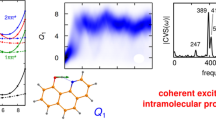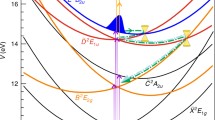Abstract
We explore the excited-state intramolecular proton transfer process of quinophthalone theoretically. This molecule possesses three low-lying singlet excited states (\(\hbox {S}_1, \hbox {S}_2\) and \(\hbox {S}_3\)) in a narrow energy gap of less than the N–H stretching frequency. Dynamics simulations show nonadiabatic wavepacket transfer to \(\hbox {S}_2\) and \(\hbox {S}_3\) upon initiating the wavepacket on \(\hbox {S}_1\). Multiple accessible conical intersections that lie in the Franck–Condon region facilitate the nonadiabatic wavepacket transfer. Nuclear densities associated with the proton transfer promoting vibrations would start accumulating on \(\hbox {S}_2\) and \(\hbox {S}_3\) within a few tens of femtoseconds, validating the involvement of these vibrations in the nonadiabatic events that occur before the proton transfer process. Our findings emphasize the necessity of refined kinetic models for assigning the time constants of ultrafast transient spectroscopy measurements due to the simultaneous evolution of nonadiabatic events and proton transfer kinetics in quinophthalone.
Graphical abstract












Similar content being viewed by others
References
LeGourrirec, D., Kharlanov, V. A., Brown, R. G., & Rettig, W. (2000). Excited-state intramolecular proton transfer (esipt) in 2-(2\(^\prime\)-hydroxyphenyl)-oxazole and -thiazole. Journal of Photochemistry and Photobiology A, 130(2), 101–111. https://doi.org/10.1016/S1010-6030(99)00206-3.
Doroshenko, A. O., Matsakov, A. Y., Nevskii, O. V., & Grygorovych, O. V. (2012). Excited state intramolecular proton transfer reaction revisited: S1 state or general reversibility? Journal of Photochemistry and Photobiology A, 250, 40–49. https://doi.org/10.1016/j.jphotochem.2012.09.010.
Kenfack, C. A., Klymchenko, A. S., Duportail, G., Burger, A., & Mly, Y. (2012). Ab initio study of the solvent h-bonding effect on esipt reaction and electronic transitions of 3-hydroxychromone derivatives. Physical Chemistry Chemical Physics, 14, 8910–8918. https://doi.org/10.1039/C2CP40869D.
Chevalier, K., Grn, A., Stamm, A., Schmitt, Y., Gerhards, M., & Diller, R. (2013). Esipt and photodissociation of 3-hydroxychromone in solution: Photoinduced processes studied by static and time-resolved uv/vis, fluorescence, and ir spectroscopy. Journal of Physical Chemistry A, 117(44), 11233–11245. https://doi.org/10.1021/jp407252y.
Simkovitch, R., & Huppert, D. (2015). Excited-state intramolecular proton transfer of the natural product quercetin. Journal of Physical Chemistry B, 119(32), 10244–10251. https://doi.org/10.1021/acs.jpcb.5b04867.
Roohi, H., & Alizadeh, P. (2019). Fine-tuned dual fluorescence behavior of n-substituted aniline-imidazopyridine based switches: Mechanistic understanding, substituent and solvent effects. Spectrochimica Acta Part A: Molecular Biomolecular Spectroscopy, 214, 407–428. https://doi.org/10.1016/j.saa.2019.02.075.
Rastogi, A., Nag, P., & Vennapusa, S. R. (2021). Tracking the early nonadiabatic events of esipt process in 2-acetylindan-1,3-dione by quantum wavepacket dynamics. Journal of Photochemistry and Photobiology A, 418, 113415. https://doi.org/10.1016/j.jphotochem.2021.113415.
Pandey, D., Nag, P., & Vennapusa, S. R. (2022). Comparative study of the multistate esipt in dihydroxyanthraquinones. Journal of Photochemistry and Photobiology A, 423, 113583. https://doi.org/10.1016/j.jphotochem.2021.113583.
Chung, M.-W., Lin, T.-Y., Hsieh, C.-C., Tang, K.-C., Fu, H., Chou, P.-T., et al. (2010). Excited-state intramolecular proton transfer (esipt) fine tuned by quinoline-pyrazole isomerism: \(\pi\)-conjugation effect on esipt. Journal of Physical Chemistry A, 114(30), 7886–7891. https://doi.org/10.1021/jp1036102.
Tang, K.-C., Chang, M.-J., Lin, T.-Y., Pan, H.-A., Fang, T.-C., Chen, K.-Y., et al. (2011). Fine tuning the energetics of excited-state intramolecular proton transfer (esipt): White light generation in a single esipt system. Journal of the American Chemical Society, 133(44), 17738–17745. https://doi.org/10.1021/ja2062693.
Jin, X., Liu, C., Wang, X., Huang, H., Zhang, X., & Zhu, H. (2015). A flavone-based esipt fluorescent sensor for detection of n2h4 in aqueous solution and gas state and its imaging in living cells. Sensors and Actuators B: Chemical, 216, 141–149. https://doi.org/10.1016/j.snb.2015.03.088.
Stasyuk, A. J., Chen, Y.-T., Chen, C.-L., Wu, P.-J., & Chou, P.-T. (2016). A new class of n-h excited-state intramolecular proton transfer (esipt) molecules bearing localized zwitterionic tautomers. Physical Chemistry Chemical Physics, 18, 24428–24436. https://doi.org/10.1039/C6CP05236C.
Han, C., Song, B., Liang, X., Pan, H., & Dong, W. (2019). Design and application of a fluorescent probe based on esipt mechanism for the detection of cys with o-hydroxyacetophenone structure. Analytical Methods, 11, 2513–2517. https://doi.org/10.1039/C9AY00708C.
Park, S., Kwon, O.-H., Lee, Y.-S., Jang, D.-J., & Park, S. Y. (2007). Imidazole-based excited-state intramolecular proton-transfer (esipt) materials: Observation of thermally activated delayed fluorescence (tdf). Journal of Physical Chemistry A, 111(39), 9649–9653. https://doi.org/10.1021/jp072212p.
Zhao, J., Ji, S., Chen, Y., Guo, H., & Yang, P. (2012). Excited state intramolecular proton transfer (esipt): From principal photophysics to the development of new chromophores and applications in fluorescent molecular probes and luminescent materials. Physical Chemistry Chemical Physics, 14, 8803–8817. https://doi.org/10.1039/C2CP23144A.
Zhou, M., Zhao, J., Cui, Y., Wang, Q., Dai, Y., Song, P., & Xia, L. (2015). Theoretical study on the excited-state intramolecular proton-transfer reaction of 10-hydroxybenzo[h]quinoline in methanol and cyclohexane. Journal of Luminescence, 161, 1–6. https://doi.org/10.1016/j.jlumin.2014.12.049.
Yang, D., Yang, G., Jia, M., Song, X., & Zhang, Q. (2018). Comparing the substituent effects about esipt process for hbo derivatives. Computational and Theoretical Chemistry, 1131, 51–56. https://doi.org/10.1016/j.comptc.2018.03.016.
Massue, J., Felouat, A., Vrit, P. M., Jacquemin, D., Cyprych, K., Durko, M., et al. (2018). An extended excited-state intramolecular proton transfer (esipt) emitter for random lasing applications. Physical Chemistry Chemical Physics, 20, 19958–19963. https://doi.org/10.1039/C8CP03814G.
Han, G. R., Hwang, D., Lee, S., Lee, J. W., Lim, E., Heo, J., & Kim, S. K. (2017). Shedding new light on an old molecule: quinophthalone displays uncommon n-to-o excited state intramolecular proton transfer (esipt) between photobases. Scientific Reports, 7, 3863–3871. https://doi.org/10.1038/s41598-017-04114-9.
Becke, A. D. (1993). Densityfunctional thermochemistry. iii. the role of exact exchange. The Journal of Chemical Physics, 98(7), 5648–5652. https://doi.org/10.1063/1.464913.
Lee, C., Yang, W., & Parr, R. G. (1988). Development of the colle-salvetti correlation-energy formula into a functional of the electron density. Physical Review B, 37(2), 785. https://doi.org/10.1103/PhysRevB.37.785.
Yanai, T., Tew, D. P., & Handy, N. C. (2004). A new hybrid exchange-correlation functional using the coulomb-attenuating method (cam-b3lyp). Chemical Physics Letters, 393(1–3), 51–57. https://doi.org/10.1016/j.cplett.2004.06.011.
Schapiro, I., Sivalingam, K., & Neese, F. (2013). Assessment of \(n\)-electron valence state perturbation theory for vertical excitation energies. Journal of Chemical Theory and Computation, 9(8), 3567–3580. https://doi.org/10.1021/ct400136y.
Frisch, M. J., Trucks, G. W., Schlegel, H. B., Scuseria, G. E., Robb, M. A., Cheeseman, J. R., Scalmani, G., Barone, V., Petersson, G. A., Nakatsuji, H., Li, X., Caricato, M., Marenich, A. V., Bloino, J., Janesko, B. G., Gomperts, R., Mennucci, B., Hratchian, H. P., Ortiz, J. V., Izmaylov, A. F., Sonnenberg, J. L., Williams-Young, D., Ding, F., Lipparini, F., Egidi, F., Goings, J., Peng, B., Petrone, A., Henderson, T., Ranasinghe, D., Zakrzewski, V. G., Gao, J., Rega, N., Zheng, G., Liang, W., Hada, M., Ehara, M., Toyota, K., Fukuda, R., Hasegawa, J., Ishida, M., Nakajima, T., Honda, Y., Kitao, O., Nakai, H., Vreven, T., Throssell, K., Montgomery, J. A. Jr., Peralta, J.E., Ogliaro, F., Bearpark, M.J., Heyd, J.J., Brothers, E. N., Kudin, K. N., Staroverov, V. N., Keith, T. A., Kobayashi, R., Normand, J., Raghavachari, K., Rendell, A.P., Burant, J. C., Iyengar, S. S., Tomasi, J., Cossi, M., Millam, J. M., Klene, M., Adamo, C., Cammi, R., Ochterski, J. W., Martin, R. L., Morokuma, K., Farkas, O., Foresman, J. B., & Fox, D. J. (2016). Gaussian 16 Revision C.01. Gaussian Inc. Wallingford CT
Neese, F. (2012). The orca program system. Wiley Interdisciplinary Reviews Computational Molecular Science,2, 73–78. https://doi.org/10.1002/wcms.81. https://wires.onlinelibrary.wiley.com/doi/pdf/10.1002/wcms.81.
Neese, F. (2018). Software update: The orca program system, version 4.0. Wiley Interdisciplinary Reviews Computational Molecular Science8, 1327 https://doi.org/10.1002/wcms.1327https://wires.onlinelibrary.wiley.com/doi/pdf/10.1002/wcms.1327.
Köppel, H., Domcke, W., & Cederbaum, L. S. (1984). Multimode molecular dynamics beyond the born-oppenheimer approximation. Advances in Chemical Physics57, 59–246. https://doi.org/10.1002/9780470142813.ch2https://onlinelibrary.wiley.com/doi/pdf/10.1002/9780470142813.ch2
Meyer, H.-D., Manthe, U., & Cederbaum, L. S. (1990). The multi-configurational time-dependent hartree approach. Chemical Physics Letters, 165, 73–78. https://doi.org/10.1016/0009-2614(90)87014-I.
Manthe, U., Meyer, H.-D., & Cederbaum, L. S. (1992). Wavepacket dynamics within the multiconfiguration hartree framework: General aspects and application to nocl. Journal of Chemical Physics, 97, 3199–3213. https://doi.org/10.1063/1.463007.
Beck, M. H., Jäckle, A., Worth, G. A., & Meyer, H.-D. (2000). The multiconfiguration time-dependent hartree (mctdh) method: A highly efficient algorithm for propagating wavepackets. Physics Reports, 324, 1–105. https://doi.org/10.1016/S0370-1573(99)00047-2.
Meyer, H.-D., Gatti, F., & Worth, G. A. (2009). Multidimensional Quantum Dynamics: MCTDH Theory and Applications. Weinheim: Wiley-VCH.
Vendrell, O., & Meyer, H.-D. (2011). Multilayer multiconfiguration time-dependent hartree method: Implementation and applications to a henonheiles hamiltonian and to pyrazine. Journal of Chemical Physics, 134(4), 044135. https://doi.org/10.1063/1.3535541.
Meng, Q., & Meyer, H.-D. (2013). A multilayer mctdh study on the full dimensional vibronic dynamics of naphthalene and anthracene cations. Journal of Chemical Physics, 138(1), 014313. https://doi.org/10.1063/1.4772779.
Meng, Q., & Meyer, H.-D. (2014). A full-dimensional multilayer multiconfiguration time-dependent hartree study on the ultraviolet absorption spectrum of formaldehyde oxide. Journal of Chemical Physics, 141(12), 124309. https://doi.org/10.1063/1.4896201.
Wang, H. (2015). Multilayer multiconfiguration time-dependent hartree theory. Journal of Physical Chemistry A, 119(29), 7951–7965. https://doi.org/10.1021/acs.jpca.5b03256.
Xie, Y., Zheng, J., & Lan, Z. (2015). Full-dimensional multilayer multiconfigurational time-dependent hartree study of electron transfer dynamics in the anthracene/c60 complex. Journal of Chemical Physics, 142(8), 084706. https://doi.org/10.1063/1.4909521.
Wang, H., & Meyer, H.-D. (2018). On regularizing the ml-mctdh equations of motion. Journal of Chemical Physics, 149(4), 044119. https://doi.org/10.1063/1.5042776.
Worth, G. A., Beck, M. H., Jäckle, A., & Meyer, H.-D. (2007). The MCTDH Package, Version 8.5. Heidelberg: University of Heidelberg.
Worth, G. A., Meyer, H., & Cederbaum, L. S. (1996). The effect of a model environment on the s2 absorption spectrum of pyrazine: A wave packet study treating all 24 vibrational modes. Journal of Chemical Physics, 105(11), 4412–4426. https://doi.org/10.1063/1.472327.
Hochstrasser, R. M. (2007). Two-dimensional spectroscopy at infrared and optical frequencies. Proceedings of the National Academy of Sciences of the United States of America104(36), 14190–14196 https://doi.org/10.1073/pnas.0704079104https://www.pnas.org/content/104/36/14190.full.pdf
Oliver, T. A. A., Lewis, N. H. C., & Fleming, G. R. (2014). Correlating the motion of electrons and nuclei with two-dimensional electronic–vibrational spectroscopy. Proceedings of the National Academy of Sciences of the United States of America111, 10061–10066 https://doi.org/10.1073/pnas.1409207111https://www.pnas.org/content/111/28/10061.full.pdf
Courtney, T. L., Fox, Z. W., Slenkamp, K. M., & Khalil, M. (2015). Two-dimensional vibrational-electronic spectroscopy. Journal of Chemical Physics, 143, 154201. https://doi.org/10.1063/1.4932983.
Lewis, N. H. C., & Fleming, G. R. (2016). Two-dimensional electronic-vibrational spectroscopy of chlorophyll a and b. Journal of Physical Chemistry Letters, 7, 831–837. https://doi.org/10.1021/acs.jpclett.6b00037.
Gaynor, J. D., Sandwisch, J., & Khalil, M. (2019). Vibronic coherence evolution in multidimensional ultrafast photochemical processes. Nature Communications, 10, 5621. https://doi.org/10.1038/s41467-019-13503-9.
Wu, E. C., Arsenault, E. A., Bhattacharyya, P., Lewis, N. H. C., & Fleming, G. R. (2019). Two-dimensional electronic vibrational spectroscopy and ultrafast excitonic and vibronic photosynthetic energy transfer. Faraday Discuss, 216, 116–132. https://doi.org/10.1039/C8FD00190A.
Acknowledgements
AB and DP acknowledge the Indian Institute of Science Education and Research Thiruvananthapuram (IISER TVM) for the doctoral fellowship. PN thanks Ministry of Higher Education, Government of India, for the doctoral fellowship under the Prime Minister’s Research Fellows (PMRF) scheme. The authors acknowledge IISER TVM for computational facilities.
Funding
No funding was received for conducting this study.
Author information
Authors and Affiliations
Corresponding author
Ethics declarations
Conflict of interest
The authors declare that they have no conflict to declare.
Supplementary Information
Below is the link to the electronic supplementary material.
Supplementary Information
Details of ground-state harmonic vibrational frequencies, vibronic coupling parameters, geometries of various stationary points and MCTDH data. These can be obtained from http://warwick.ac.uk/chrisoates/. (pdf 1934KB)
Rights and permissions
About this article
Cite this article
Bera, A., Nag, P., Pandey, D. et al. Theoretical approach to modeling the early nonadiabatic events of ESIPT originating from three-state conical intersection in quinophthalone. Photochem Photobiol Sci 21, 1287–1298 (2022). https://doi.org/10.1007/s43630-022-00220-4
Received:
Accepted:
Published:
Issue Date:
DOI: https://doi.org/10.1007/s43630-022-00220-4




